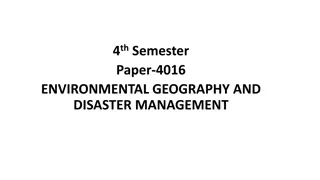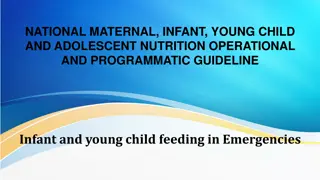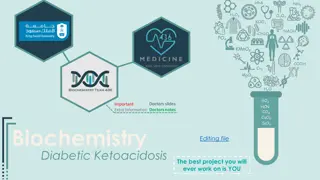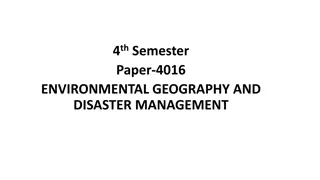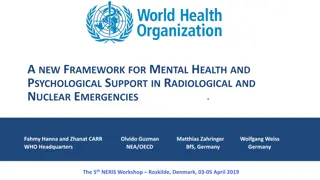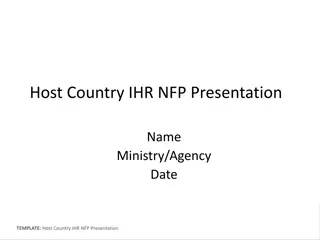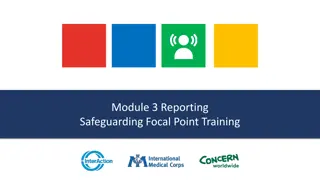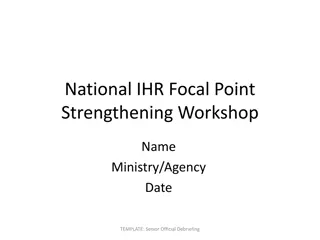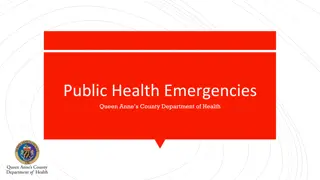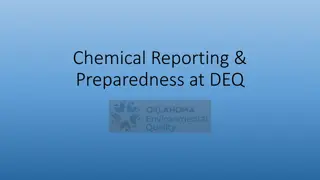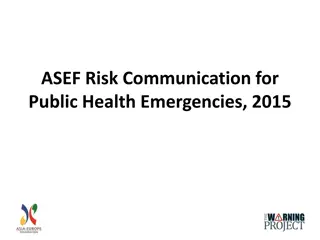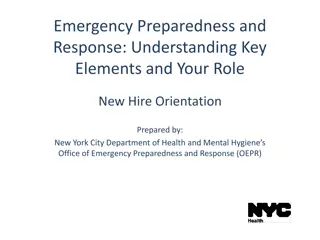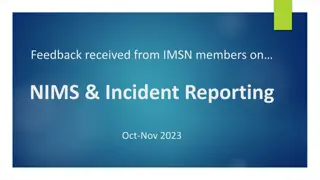Understanding International Health Regulations (IHR): Reporting and Communication Mechanisms for Health Emergencies
This comprehensive overview explores the roles of National IHR Focal Points, responsible authorities for reporting under IHR, operational frameworks, communication channels, notification processes, and engagement with WHO in managing health emergencies. It also delves into the assessment criteria for Public Health Emergencies of International Concern (PHEIC) and the initial communication protocols between National IHR Focal Points and WHO Contact Points.
Download Presentation

Please find below an Image/Link to download the presentation.
The content on the website is provided AS IS for your information and personal use only. It may not be sold, licensed, or shared on other websites without obtaining consent from the author. Download presentation by click this link. If you encounter any issues during the download, it is possible that the publisher has removed the file from their server.
E N D
Presentation Transcript
National IHR Focal Points Overview of IHR Information- Sharing Mechanisms HEALTH EMERGENCIES programme
Outline Responsible authorities for reporting under the IHR IHR operational framework Types of notifications and communications Regional IHR event management Challenges/questions HEALTH EMERGENCIES programme
Responsible Authorities Notification Reports Consultation Verification National IHR National IHR Focal Point Focal Point (One per State Party) National IHR Focal Point means the national centre, designated by each State Party, which shall be accessible at all times for communications with WHO IHR Contact Points under these Regulations WHO IHR WHO IHR Contact Point Contact Point (One per WHO Region) WHO IHR Contact Point means the unit within WHO which shall be accessible at all times for communications with the National IHR Focal Point HEALTH EMERGENCIES programme
IHR Operational Framework Determine Public Health Emergency of International Concern (PHEIC) Make temporary and standing recommendations Emergency Committee WHO Expert Roster Director-General Review Committee 24/7 accessibility Primary channel for WHO-NFP event- related communications Disseminate information within WHO "Activate" the WHO assessment and response system Other competent organizations (IAEA etc.) WHO IHR Regional Contact Points Notification Consultation Report Verification Art.6-12 Annex 1.A 24/7 accessibility Communication with WHO Dissemination of information nationally Consolidating input nationally National IHR Focal Points (NFP) Ministries and sectors concerned Art.4 Detect Assess Report Respond Unusual health events National surveillance and response systems Incl. Points of Entry Annex 1 Art.22 Art.27 HEALTH EMERGENCIES programme
Initial communication between IHR NFP and WHO IHR Contact Points Annex 2: algorithm of decision for national authorities to engage in a dialogue with PAHO/WHO; it is not the equivalent of risk assessment How Annex 2 is used (levels, mechanical use); Who is using it? Tools to support the use of Annex 2 (e.g., forms) Joint risk assessment process: State Party and WHO/PAHO assessment against the four criteria HEALTH EMERGENCIES programme
What type of event should be notified under the IHR? Four immediately notifiable conditions: Smallpox Polio (due to wild-type poliovirus) Human influenza caused by a new subtype SARS Four criteria to decide on notification: Is the public health impact of the event serious? Is the event unusual or unexpected? Is there any significant risk of international spread? Is there any significant risk of international travel or trade restrictions? HEALTH EMERGENCIES YES to any two (2) or more criteria indicates that notification of the WHO is required programme
National biosurveillance infrastructure Local responsibility to detect and respond immediately to an event WHO Notification Essential public health activities absolutely critical to global health security How to fulfill this responsibility at the global scale? Who is responsible for this at the global scale? Kenneth D. Mandl et al. J Am Med Inform Assoc 2004;11:141-150 HEALTH EMERGENCIES programme 6
IHR(2005): Working Together to Secure Global Health Types of IHR communications Article 6 Notification Use Annex 2 to assess events and notify WHO by way of the National IHR Focal Point, all events that may constitute a potential public health emergency of international concern (PHEIC). Article 8 Consultation If notification under Article 6 is not required, (especially if insufficient information), consider entering into a consultation / discussion with WHO on appropriate health measures / next steps. Article 9 Other reports WHO may take into account reports from other sources (i.e., reports from other countries, informal information, media reports, etc.). HEALTH EMERGENCIES 7 programme
Types of IHR communications Article 9 Other reports: WHO may take into account reports from other sources (i.e., reports from other countries, informal information, media reports, etc.). States Parties, shall inform WHO within 24 hours of receipt of evidence of a public health risk identified outside of their territory as manifested by exported or imported Article 10 Verification Requests : Responding to WHO requests for verification of reports from sources other than notifications or consultations of events which may constitute a public health emergency of international concern allegedly occurring in the State's territory Article 44 Collaboration and Assistance: States Parties shall undertake to collaborate with each other, to the extent possible, in the detection and assessment of, and response to, events as provided under these regulations. Furthermore, collaboration under this Article may be implemented through multiple channels, including bilaterally, through regional networks and the WHO Regional Offices, and through intergovernmental organizations and international bodies. HEALTH EMERGENCIES programme
Verification request Reasons for WHO Regional IHR Contact Point to initiate verification dialogue with States Parties Strong indications of international public health implications Maintaining the channels of communication open Opportunity to support capacity building activities Lack of information/access to additional sources to triangulate the information WHO approached by IHR NFP for verification/confirmation purposes Verification and triggered notification NFPs that shared internal daily/weekly report with WHO are not overburdened. WHO is already aware. HEALTH EMERGENCIES programme
Most are infectious diseases There are other international alert and response networks, such as: INFOSAN: Food safety event DRUG ALERT: SSFFC: WHA 65.19 USIE-IAEA: radio nuclear events Need to coordinate and consolidate information from different sectors to ensure consistent information is shared internationally. OIE: zoonosis SAICM: Approach to International Chemicals Management HEALTH EMERGENCIES programme
Summary The IHR NFP is responsible for notifying the WHO IHR Regional Contact Point Event notifications under the IHR are the official position and information from a State Party and are national public health responsibility/obligation under the IHR, which cannot be contracted to non-government entities Countries should adapt domestic processes to ensure that the IHR NFP can quickly access/receive event information within the timelines set by the IHR to coordinate and make notifications to the WHO Adapting existing information flows for the IHR NFP to receive information directly from several institutions, and information about events of varying magnitude, and working to improve the flows between these institutions, improves processes for making decisions about when and which events to notify using Annex 2 Pan American Health Organization / World Health Organization. Multilateral IHR NFP Strengthening Workshop Toolkit. June. Washington, DC: PAHO/WHO; 2017 HEALTH EMERGENCIES programme
Pan American Health Organization / World Health Organization. Multilateral IHR NFP Strengthening Workshop Toolkit. June. Washington, DC: PAHO/WHO; 2017 HEALTH EMERGENCIES programme


